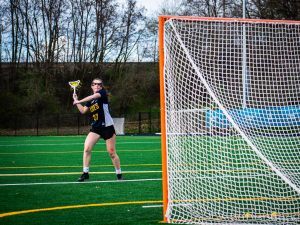For the past two years, Student Agriculture at Whitman (SAW) has been providing Bon Appétit salad bars with crops of micro-greens grown in the greenhouse on the roof of the science building. This year the group is expanding its crops to include both a lettuce mix and basil.
Junior Natalie Jamerson, the president of SAW, planted a dozen basil plants before school began and more plants were later planted and maintained by other group members. There is now a total of 50 basil plants in the greenhouse, which will be harvested later this month.
The lettuce mix is still in its testing stages, but should be ready later in the semester.
“Bon Appétit specifically asked for basil. We want not to just be producing but also filling needs,” Jamerson said.
SAW group member and sophomore Grady Olson is similarly excited about the new crops and their potential.
“We’ve been wanting to do salad greens for a long time . . . to sell something that we know everybody always eats,” he said.
While SAW is part of the many green groups on campus, it is primarily a business. The group sells its produce and uses the funds to produce crops for the following year.
“It is a practical skill, running a business. I love that. Planting things you can do on your own, but the business aspect you can’t,” said Olson.
Although SAW only just became an ASWC-recognized club in spring 2011, the group began two years ago with the help of the Sustainability Revolving Loan Fund (SRLF). The SRLF is a loan given to students on the condition that it will be repaid within five years. SAW was able to repay its loan in spring 2011, and it now has a large budget for the group’s expenses.
One of the group’s major expenses is seed, which is imported from Maine.
“They are not the most local, but they are dependable. We have the budget to buy good seed. Since we need to produce sellable, dependable crop we don’t want to take chances,” said Jamerson.
Currently, SAW only sells its produce to Bon Appétit. According to Jamerson, at $18 a tray, the micro-greens are a very lucrative crop. SAW anticipates that the basil will sell for about $8 per pound.
“Bon Appétit is really into buying what we produce. It’s part of their philosophy to buy from student agriculture,” said sophomore Lydia Bailey, a member of SAW.
According to Bon Appétit’s handbook, which is available online, the company’s goal is to “purchase seasonal and regional ingredients from local small farmers and artisans within a 150-mile radius of [its] kitchen.”
SAW is primarily run by student volunteers, at least one of whom is usually an environmental studies intern. For one environmental studies credit, interns research ways in which the group can expand and more thoroughly address the goals of the group.
The group’s goals are to both promote learning about local food and to increase the amount of local food on campus.
“It makes sense to promote [the] educational aspect of growing food,” said Jamerson.
Although SAW has made great strides within the past two years, because there is so much overlap with environmentally sustainable clubs at Whitman, SAW has had some difficulty finding its niche, particularly in the usage of on-campus resources.
“We can’t reliably count on the biology greenhouse. In spring during the plant biology class and senior thesis projects, SAW has the least right-of-way to use the greenhouse,” said Bailey.
Junior Andrew Strong and senior Jo French are currently researching the plausibility of building a separate greenhouse on campus. This potential greenhouse wouldn’t just be for SAW, but the group needs will be considered in the formulation of the greenhouse. The greenhouse may also benefit students who live off campus and are not on a meal plan. Strong and French plan to consult Landscape Specialist Bob Biles, members of the community and previous environmental studies interns who have researched similar projects.
“The one thing I’m a little hesitant of . . . is whether [a greenhouse] is going to fit well into the community or is it going to be something that is over-stepping programs we already have and other options that could potentially be more productive,” said Strong. “It would be really cool to see a greenhouse constructed in the next few years.”
By the end of the semester, Strong and French intend to create a proposal for a greenhouse that other students can use as a starting point.
Meanwhile, SAW is constantly learning and growing. Just this past week, the group discovered that a new germination method for their micro-green crops yielded much better results. The group credits Bailey for coming up with the new method.
“SAW taught me a lot about the business side of agricultural organization, like the importance of planning planting schedule and plant problem-solving skills. It’s fun. I like finding better ways to farm,” said Bailey.
You can stay up to date on SAW by visiting their blog: studentagwhitman.wordpress.com/








